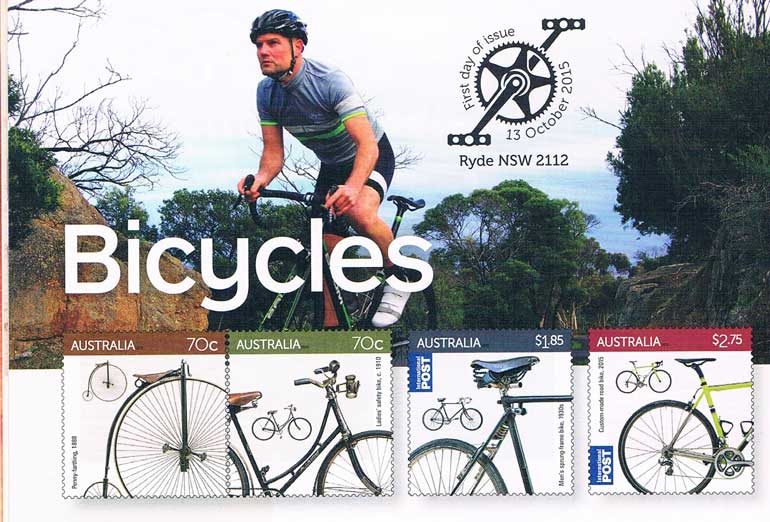Wednesday Jan 07, 2026
Wednesday Jan 07, 2026
Saturday, 7 November 2015 00:00 - - {{hitsCtrl.values.hits}}

‘Bicycale bicyccale – Duppath apage bicycale…’
Vincent de Paul Peris’ song on the ‘Poor pan’s bicycle’ became a hit the very day he sang it. The words were simple and easy to remember. The catchy tune could be picked easily. Along with ‘Siripade Samanala Kanda Pene’, Vincent de Paul had given music lovers two wonderful songs. That was over five decades ago. To this day the songs have not lost their charm.
Just as much as we would not think about anyone composing a song about the commonest mode of transport to get about easily, not many stamp collectors may think of stamps as a subject for a new issue. Yet that’s what Australia Post did last month. Four stamps of different denominations were released.
The history of the bicycle is fascinating. So is its rapid development with numerous modifications being done to keep moving with time. It has been a long journey since the mid-19th century.
Described as “a human-powered, pedal-driven, single-track vehicle, having two wheels attached to a frame, one behind the other,” the bicycle is easy to manoeuvre. It’s economical. It’s handy.
A wooden Draisene – essentially propelled by the seated rider running – also known as the Dandy Horse, invented by Baron Karl Drais in Mannheim, Germany and patented in France in 1818, is regarded as the archetype of the bicycle.
The human-powered vehicle was the first means of transport to make use of the two-wheeler principle. Its rider sat astride a wooden frame supported by two in-line wheels and pushed the vehicle along with his feet while steering the front wheel.
While mention has been made of others who had tried out two-wheelers based on the Draisene, two Frenchmen – Pierre Miichaux and Pierrs Lallement - had taken the bicycle design in a new direction by adding a mechanical crank drive with pedals on an enlarged front wheel. This was called the velocipede.
There was obviously lot of interest in the invention since several others have tried using rear-wheel drive. Scotsman Thomas McCall is credited with the invention of the rod-driven velocipede in 1869. In the same year bicycle wheels with spokes had been patented by Eugene Meyer of Paris.
It is a French velocipede made of iron and wood that was developed into what is commonly known as an ‘ordinary bicycle’. It featured a tubular steel frame on which were mounted wire-spoked wheels with solid rubber tyres. These were difficult to ride due to the high seat and poor weight distribution.
Innovations continued with the accent on increased comfort. The 1890s was considered the Golden Age of Bicycles. Scotsman John Boyd Dunlop introduced the first pneumatic tyre, which soon became universal. Rear free-wheel enabling the rider to coast, gears and hand-operated cable-pull brakes and other new features were developed.
The tricycle, quadricycle and “sociable” were also developed but it was the two-wheeler that has been enduring and proved itself the most historically and socially important.
Cycling clubs began to be established and flourished by the turn of the century and touring and racing became widely popular.
The stamps feature four models manufactured in Australia over the years. They are (from left to right) a Basset & Co. penny-farthing (1888), a Southerland ladies’ safety cycle (1910), a Finlay Bros sprung-frame men’s safety bike (1930s)and a contemporary custom made road bike (2015) by Baum Cycles. It’s not over – new models continue to be made.